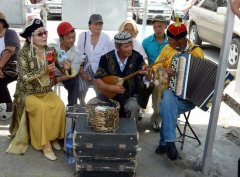As everyone knows, Mongolia is made up of a large territory with a small population. There are no ethnic minorities here except for the Kazakhs. The Kazakhs of Mongolia make up about 6 percent of the total Mongolian population of 2,700,000. This is a relatively small minority and is represented by three Members of the Mongolian Parliament. In any country, it is understandable that there will be speculation about the relationship between people of the majority and the minority. Mongolian Kazakhs are very lucky in this case. If you visit Bayan Ulgii aimag, where Kazakhs pre-dominantly live, you will see that everyone speaks Kazakh. People seem to speak Kazakh there more than in Kazakhstan. Therefore, even the Vice Minister of Education, Culture and Science Mrs. Kulanda (an ethnic Kazakh) urged Kazakhs to study Mongolian in her speech during last week’s Prime Minister S. Batbold’s visit to Bayan Ulgii.
To put this in a historical perspective, Kazakhs came to Mongolia after the 1864 Tarbagatai protocol between Russia and the Qing Dynasty. Some western sources record that Kazakhs came after the Bolshevik revolution in Russia. Either way, Mongolian Kazakhs had a very interesting history during the first half of the 20th century. Between 1921 and 1940, the Kazakhs were administered by Chandamani Uul aimag, then in Hovd aimag. In 1940, in order to assist Soviet operations in Xinjiang, a new aimag was found for the Kazakhs and Altai Uriyankhais – Bayan Ulgii. Until 1945, Mongolians provided military support to Kazakh resistance fighter Osman. Chinese recognition of Mongolian independence in 1946 saw the end of that operation. Then, Bayan Ulgii aimag survived as a normal aimag despite the abortion of the operation in Xinjiang.
Later, Soviet style industrialization brought many Kazakhs to the coal mines of Nalaikh and other industrial sites such as Erdenet and Darkhan.
Since Mongolians followed Soviet style ethnic policy, many Mongolian Kazakhs received good education along with the Mongolians. They achieved the highest positions in the Communist party, Government and Armed Forces. Therefore, Kazakhs used to know three languages: Kazakh, Mongolian and Russian. For example, the rector of the High Party School was Kazakh national, Mr. Hurmatbek. His deputy was Mr. Miegombo, father of the current Deputy Prime Minister Mr. M. Enkhbold.
The Democratic revolution of 1991 brought many Kazakhs to the Mongolian Democratic Party, such as Mrs. Kulanda, current Vice Minister of Education, Culture and Science, Mr. Murat, former Member of Parliament, Mr. K. Sairan, former Member of Parliament, current Mongolian ambassador to Kuwait, but some of them kept their membership with the former Communist Party (Mongolian People’s Revolutionary Party), such as all three current Members of Parliament from Bayan Ulgii.
The Democratic revolution was accompanied by a drastic economic crisis mostly due to the collapse of the Soviet Union and also the Eastern Bloc cut all traditional economic ties. In 1992, the President of Kazakhstan Mr. N. Nazarbaev invited all overseas Kazakhs to return to their homeland. By 1994, some 60,000 Kazakhs had left Mongolia. Some of them returned back to Mongolia later or they maintain dual citizenship, which is illegal by Mongolian law.
Of course, the current country of Kazakhstan is not just a big replica of Bayan Ulgii. Kazakhs from Kazakhstan speak a different form of the Kazakh language; there are many other ethnic groups in Kazakhstan. Russian is still widely used in organizations and companies. Kazakhstan has put forward an ambitious goal to require the Kazakh language to be used in all governmental organizations. Later it will gradually become required in businesses and other places, such as hospitals, universities etc. Even Kazakhs agree that Mongolian Kazakhs speak better Kazakh than Kazakhs from Kazakhstan; having kept their Kazakh traditions alive.
Unfortunately, the transition to a market economy in Mongolia did not bring big benefits for Bayan Ulgii. Like any remote province in Mongolia, Bayan Ulgii suffered from the collapse of the socialist system; artificially created plants and industries buckled. Suddenly, all services and goods became very expensive. Of course, people from other provinces fled to Ulaanbaatar city. People of Bayan Ulgii preferred to stay there or to move to Kazakhstan. Air tickets to Bayan Ulgii are nearly the same price as a ticket to fly to Beijing or even to Seoul. Since the democratic revolution, Kazakhs paid more attention to the Kazakh language and most of the teachers left the country or province. Interestingly, Bayan Ulgii is rich with mineral deposits. The biggest reserve of silver (Asgat) is located there. Mongolians, along with Kazakhs lost a unique opportunity to start operations of Asgat in 2007 when the Russian company Polymetal was ready to start operations there. Unfortunately, now Bayan Ulgii is the poorest province in all of Mongolia. In terms of social welfare and education it holds all of the last place positions among other provinces.
Of course, Kazakhstan could make many remarkable changes in Bayan Ulgii aimag if they choose to. Unfortunately, Kazakhstan officials prefer to visit Ulaanbaatar city when they come.
Kazakhstan does, however, try to invest in Mongolia. Unfortunately, there is one big obstacle for Kazakhstan’s investments here. During socialist times, Mongolia’s Erdenet plant did not receive several millions USD from the Kazakhstan plant it said was owed to them. This situation has yet to be resolved. For Mongolia, this is still considered to be a huge amount of money, and for the Kazakhs it is quite difficult for them to accept this debt. If they accept this debt, the worry is that later others might come forward with similar claims.
In 2006, a huge Kazakhstan delegation under the leadership of Kazakhstan’s Minister of Foreign Affairs K. Tokayev visited Mongolia. At that time, he stated that the Republic of Kazakhstan plans to invest 2 billion USD in Mongolia.
Unfortunately, Kazakhstan spent three years doing reconnaissance and in the end, they basically withdrew from Mongolia. It is clear that Kazakhstan does not yet have substantial experience with foreign investment, which was the main reason for their failure in Mongolia.
No one knows what the future holds for local Kazakhs. They might fly back to Kazakhstan or they might continue living with Mongolians. At the end of the day, the future of Mongolian Kazakhs is in the hands of local Kazakhs themselves.


